light CHEVROLET KODIAK 2007 User Guide
[x] Cancel search | Manufacturer: CHEVROLET, Model Year: 2007, Model line: KODIAK, Model: CHEVROLET KODIAK 2007Pages: 430, PDF Size: 6.06 MB
Page 99 of 430
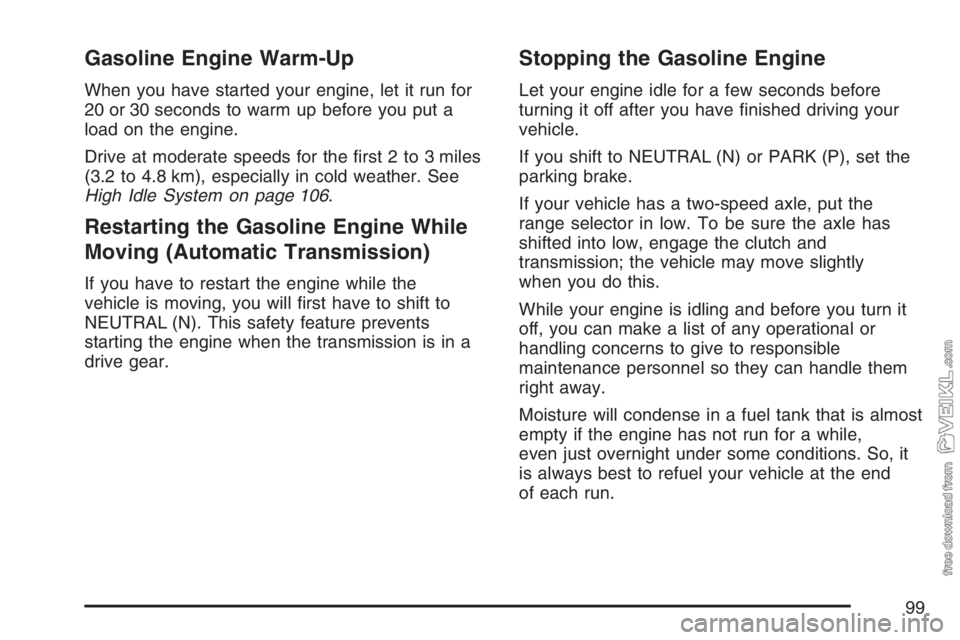
Gasoline Engine Warm-Up
When you have started your engine, let it run for
20 or 30 seconds to warm up before you put a
load on the engine.
Drive at moderate speeds for the first 2 to 3 miles
(3.2 to 4.8 km), especially in cold weather. See
High Idle System on page 106.
Restarting the Gasoline Engine While
Moving (Automatic Transmission)
If you have to restart the engine while the
vehicle is moving, you will first have to shift to
NEUTRAL (N). This safety feature prevents
starting the engine when the transmission is in a
drive gear.
Stopping the Gasoline Engine
Let your engine idle for a few seconds before
turning it off after you have finished driving your
vehicle.
If you shift to NEUTRAL (N) or PARK (P), set the
parking brake.
If your vehicle has a two-speed axle, put the
range selector in low. To be sure the axle has
shifted into low, engage the clutch and
transmission; the vehicle may move slightly
when you do this.
While your engine is idling and before you turn it
off, you can make a list of any operational or
handling concerns to give to responsible
maintenance personnel so they can handle them
right away.
Moisture will condense in a fuel tank that is almost
empty if the engine has not run for a while,
even just overnight under some conditions. So, it
is always best to refuel your vehicle at the end
of each run.
99
Page 100 of 430
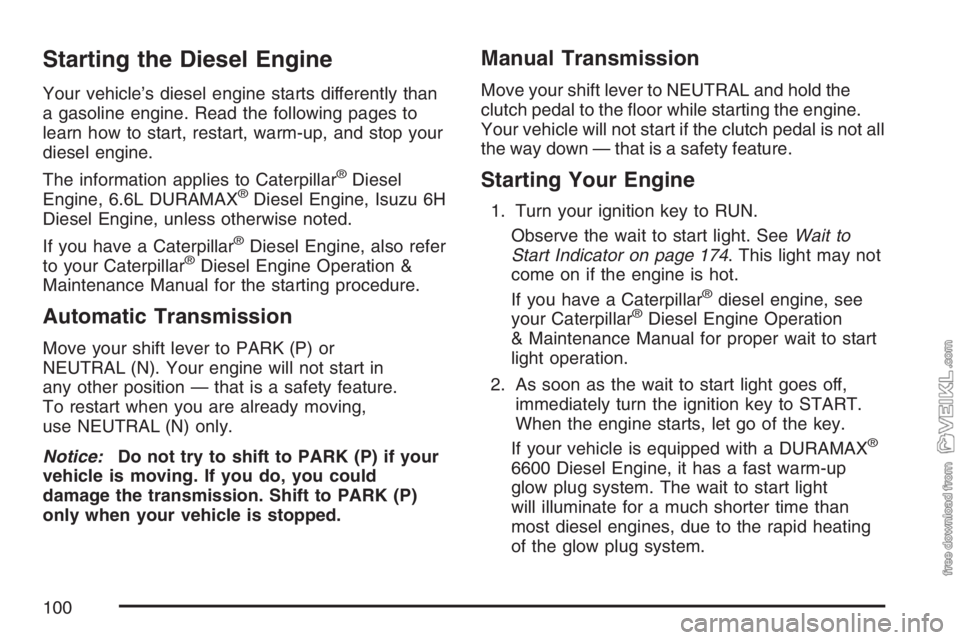
Starting the Diesel Engine
Your vehicle’s diesel engine starts differently than
a gasoline engine. Read the following pages to
learn how to start, restart, warm-up, and stop your
diesel engine.
The information applies to Caterpillar
®Diesel
Engine, 6.6L DURAMAX®Diesel Engine, Isuzu 6H
Diesel Engine, unless otherwise noted.
If you have a Caterpillar
®Diesel Engine, also refer
to your Caterpillar®Diesel Engine Operation &
Maintenance Manual for the starting procedure.
Automatic Transmission
Move your shift lever to PARK (P) or
NEUTRAL (N). Your engine will not start in
any other position — that is a safety feature.
To restart when you are already moving,
use NEUTRAL (N) only.
Notice:Do not try to shift to PARK (P) if your
vehicle is moving. If you do, you could
damage the transmission. Shift to PARK (P)
only when your vehicle is stopped.
Manual Transmission
Move your shift lever to NEUTRAL and hold the
clutch pedal to the floor while starting the engine.
Your vehicle will not start if the clutch pedal is not all
the way down — that is a safety feature.
Starting Your Engine
1. Turn your ignition key to RUN.
Observe the wait to start light. SeeWait to
Start Indicator on page 174. This light may not
come on if the engine is hot.
If you have a Caterpillar
®diesel engine, see
your Caterpillar®Diesel Engine Operation
& Maintenance Manual for proper wait to start
light operation.
2. As soon as the wait to start light goes off,
immediately turn the ignition key to START.
When the engine starts, let go of the key.
If your vehicle is equipped with a DURAMAX
®
6600 Diesel Engine, it has a fast warm-up
glow plug system. The wait to start light
will illuminate for a much shorter time than
most diesel engines, due to the rapid heating
of the glow plug system.
100
Page 101 of 430
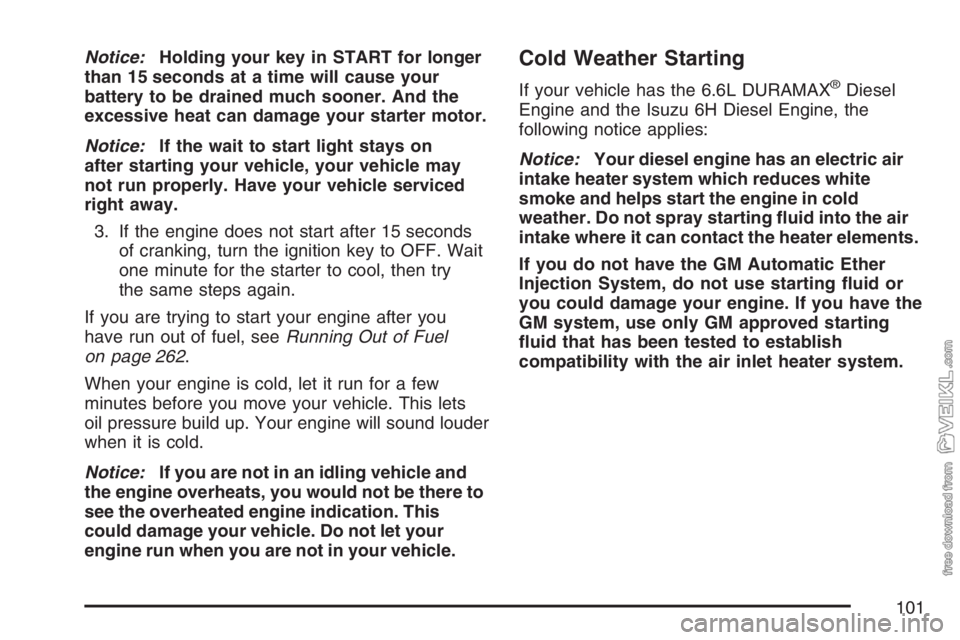
Notice:Holding your key in START for longer
than 15 seconds at a time will cause your
battery to be drained much sooner. And the
excessive heat can damage your starter motor.
Notice:If the wait to start light stays on
after starting your vehicle, your vehicle may
not run properly. Have your vehicle serviced
right away.
3. If the engine does not start after 15 seconds
of cranking, turn the ignition key to OFF. Wait
one minute for the starter to cool, then try
the same steps again.
If you are trying to start your engine after you
have run out of fuel, seeRunning Out of Fuel
on page 262.
When your engine is cold, let it run for a few
minutes before you move your vehicle. This lets
oil pressure build up. Your engine will sound louder
when it is cold.
Notice:If you are not in an idling vehicle and
the engine overheats, you would not be there to
see the overheated engine indication. This
could damage your vehicle. Do not let your
engine run when you are not in your vehicle.Cold Weather Starting
If your vehicle has the 6.6L DURAMAX®Diesel
Engine and the Isuzu 6H Diesel Engine, the
following notice applies:
Notice:Your diesel engine has an electric air
intake heater system which reduces white
smoke and helps start the engine in cold
weather. Do not spray starting �uid into the air
intake where it can contact the heater elements.
If you do not have the GM Automatic Ether
Injection System, do not use starting �uid or
you could damage your engine. If you have the
GM system, use only GM approved starting
�uid that has been tested to establish
compatibility with the air inlet heater system.
101
Page 103 of 430
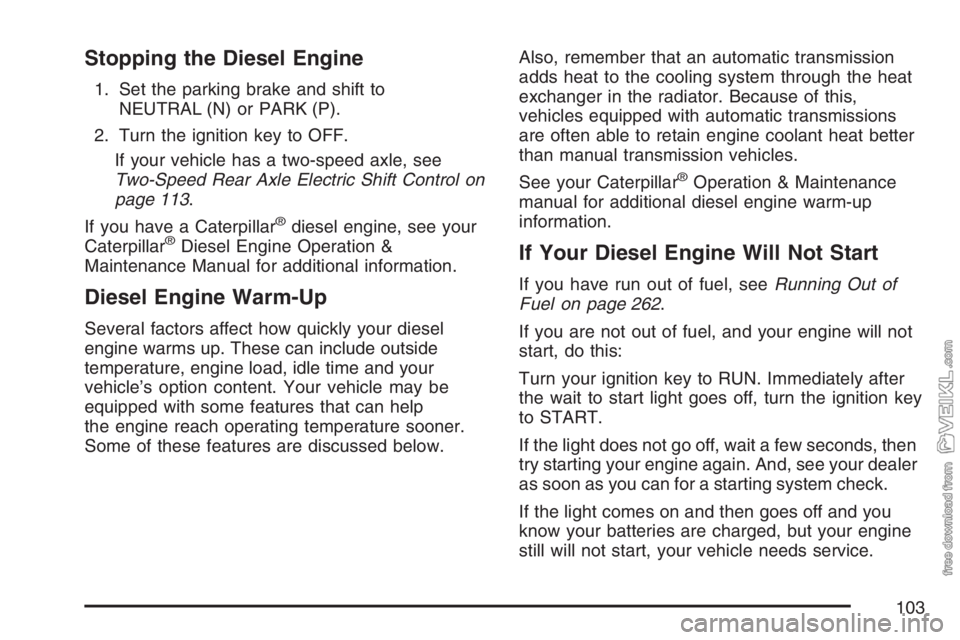
Stopping the Diesel Engine
1. Set the parking brake and shift to
NEUTRAL (N) or PARK (P).
2. Turn the ignition key to OFF.
If your vehicle has a two-speed axle, see
Two-Speed Rear Axle Electric Shift Control on
page 113.
If you have a Caterpillar
®diesel engine, see your
Caterpillar®Diesel Engine Operation &
Maintenance Manual for additional information.
Diesel Engine Warm-Up
Several factors affect how quickly your diesel
engine warms up. These can include outside
temperature, engine load, idle time and your
vehicle’s option content. Your vehicle may be
equipped with some features that can help
the engine reach operating temperature sooner.
Some of these features are discussed below.Also, remember that an automatic transmission
adds heat to the cooling system through the heat
exchanger in the radiator. Because of this,
vehicles equipped with automatic transmissions
are often able to retain engine coolant heat better
than manual transmission vehicles.
See your Caterpillar
®Operation & Maintenance
manual for additional diesel engine warm-up
information.
If Your Diesel Engine Will Not Start
If you have run out of fuel, seeRunning Out of
Fuel on page 262.
If you are not out of fuel, and your engine will not
start, do this:
Turn your ignition key to RUN. Immediately after
the wait to start light goes off, turn the ignition key
to START.
If the light does not go off, wait a few seconds, then
try starting your engine again. And, see your dealer
as soon as you can for a starting system check.
If the light comes on and then goes off and you
know your batteries are charged, but your engine
still will not start, your vehicle needs service.
103
Page 104 of 430
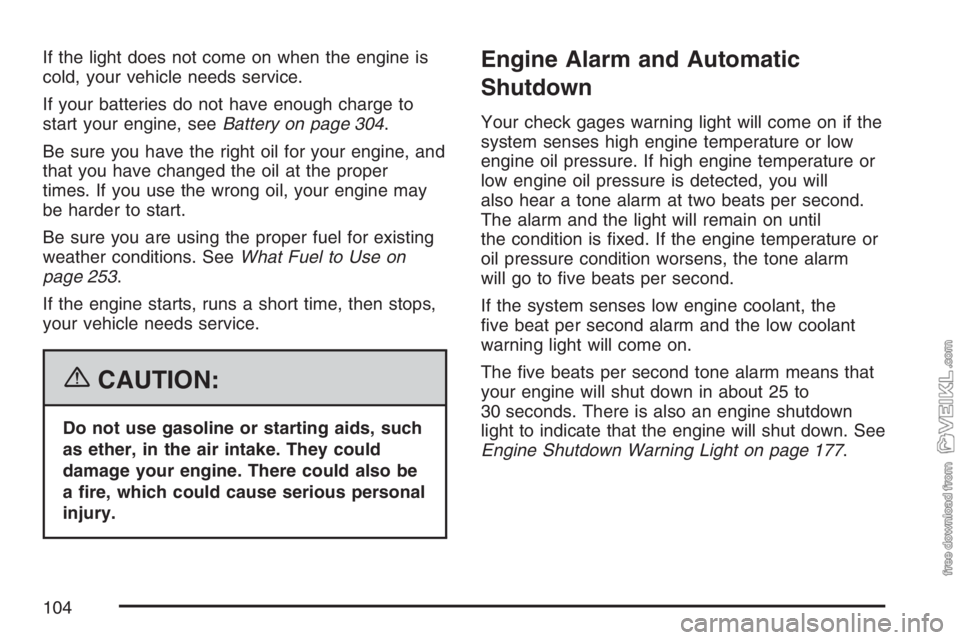
If the light does not come on when the engine is
cold, your vehicle needs service.
If your batteries do not have enough charge to
start your engine, seeBattery on page 304.
Be sure you have the right oil for your engine, and
that you have changed the oil at the proper
times. If you use the wrong oil, your engine may
be harder to start.
Be sure you are using the proper fuel for existing
weather conditions. SeeWhat Fuel to Use on
page 253.
If the engine starts, runs a short time, then stops,
your vehicle needs service.
{CAUTION:
Do not use gasoline or starting aids, such
as ether, in the air intake. They could
damage your engine. There could also be
a �re, which could cause serious personal
injury.
Engine Alarm and Automatic
Shutdown
Your check gages warning light will come on if the
system senses high engine temperature or low
engine oil pressure. If high engine temperature or
low engine oil pressure is detected, you will
also hear a tone alarm at two beats per second.
The alarm and the light will remain on until
the condition is fixed. If the engine temperature or
oil pressure condition worsens, the tone alarm
will go to five beats per second.
If the system senses low engine coolant, the
five beat per second alarm and the low coolant
warning light will come on.
The five beats per second tone alarm means that
your engine will shut down in about 25 to
30 seconds. There is also an engine shutdown
light to indicate that the engine will shut down. See
Engine Shutdown Warning Light on page 177.
104
Page 105 of 430
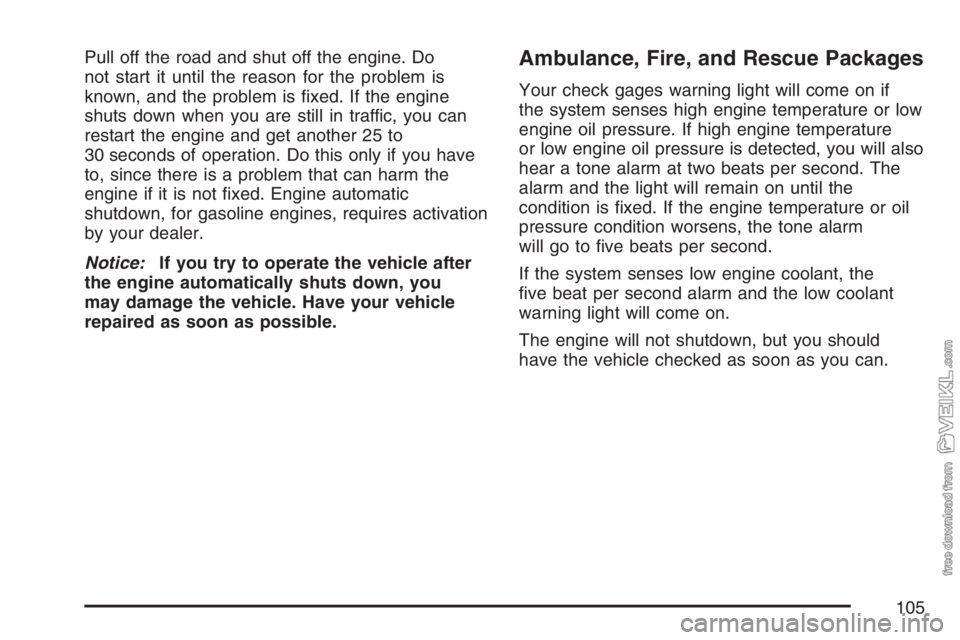
Pull off the road and shut off the engine. Do
not start it until the reason for the problem is
known, and the problem is fixed. If the engine
shuts down when you are still in traffic, you can
restart the engine and get another 25 to
30 seconds of operation. Do this only if you have
to, since there is a problem that can harm the
engine if it is not fixed. Engine automatic
shutdown, for gasoline engines, requires activation
by your dealer.
Notice:If you try to operate the vehicle after
the engine automatically shuts down, you
may damage the vehicle. Have your vehicle
repaired as soon as possible.Ambulance, Fire, and Rescue Packages
Your check gages warning light will come on if
the system senses high engine temperature or low
engine oil pressure. If high engine temperature
or low engine oil pressure is detected, you will also
hear a tone alarm at two beats per second. The
alarm and the light will remain on until the
condition is fixed. If the engine temperature or oil
pressure condition worsens, the tone alarm
will go to five beats per second.
If the system senses low engine coolant, the
five beat per second alarm and the low coolant
warning light will come on.
The engine will not shutdown, but you should
have the vehicle checked as soon as you can.
105
Page 108 of 430

Exhaust Restrictor
(Engine Warm-Up)
Exhaust Restrictor
If your vehicle has a Isuzu 6H or Caterpillar®
Diesel Engine, it may have a feature called
an Exhaust Restrictor (NPE), which uses an air
actuated valve in the exhaust system to restrict
exhaust gas flow which enhances the engine and
heater warm-up.
Automatic Quick Warm-Up
If your vehicle has a DURAMAX®6600 engine, it
has a feature called an Automatic Quick
Warm-Up, which uses the turbocharger to restrict
the exhaust gas flow which enhances the
engine and heater warm-up.
In both systems, exhaust restrictor or automatic
quick warm-up, the cold temperature high
idle feature elevates the engines idle speed, up to
1500 rpm, and restricts the exhaust gas flow,
when outside temperatures are below 32°F (0°C),
and the engine coolant temperature is below
certain levels. This feature enhances heater
performance by raising the engine coolant
temperature faster.For all engines this feature is already turned on.
The automatic quick warm-up on the DURAMAX
®
engine can be turned off and on by doing the
following procedure:
1. Turn the ignition to RUN, with the vehicle off.
2. Press the accelerator pedal to the floor
and hold it while quickly pressing and
fully releasing the brake pedal three times in
less than eight seconds.
3. Release the accelerator pedal and start the
engine. The green exhaust brake/restrictor
light below the radio controls will be lit
for 10 seconds.
If this feature is turned off, by doing the
procedure described previously, and then the
engine is started, the exhaust brake/restrictor
light will flash for 10 seconds and then it
will turn off.
When the engine is started, it will slowly increase to
the high idle speed after a delay of a few seconds;
up to about two minutes. For this method to work
properly there must be no throttle or brake pedal
faults, and the throttle pedal must not fall below
75 percent of wide open throttle while pressing the
brake pedal.
108
Page 109 of 430
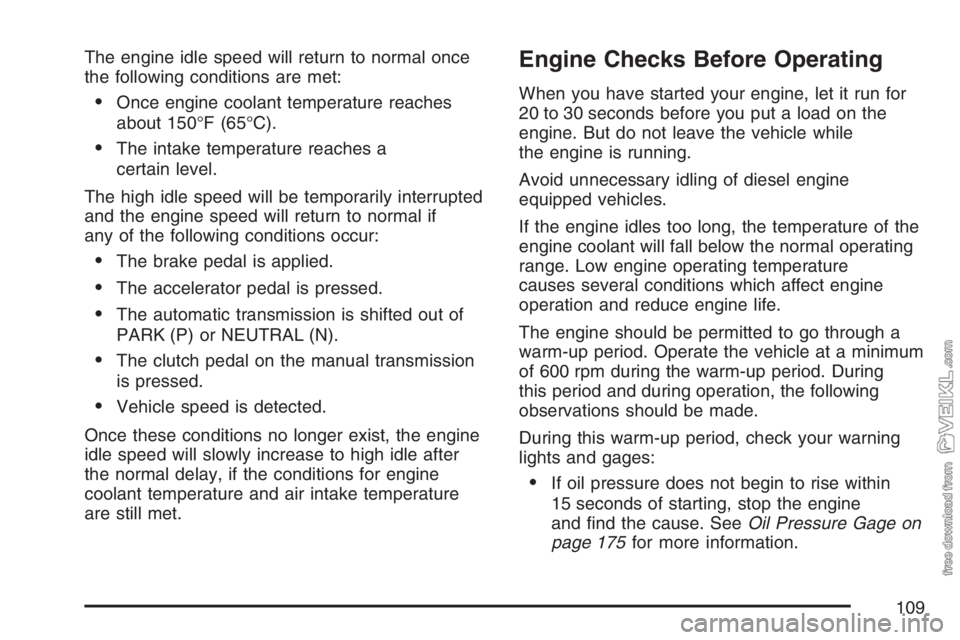
The engine idle speed will return to normal once
the following conditions are met:
•Once engine coolant temperature reaches
about 150°F (65°C).
•The intake temperature reaches a
certain level.
The high idle speed will be temporarily interrupted
and the engine speed will return to normal if
any of the following conditions occur:
•The brake pedal is applied.
•The accelerator pedal is pressed.
•The automatic transmission is shifted out of
PARK (P) or NEUTRAL (N).
•The clutch pedal on the manual transmission
is pressed.
•Vehicle speed is detected.
Once these conditions no longer exist, the engine
idle speed will slowly increase to high idle after
the normal delay, if the conditions for engine
coolant temperature and air intake temperature
are still met.
Engine Checks Before Operating
When you have started your engine, let it run for
20 to 30 seconds before you put a load on the
engine. But do not leave the vehicle while
the engine is running.
Avoid unnecessary idling of diesel engine
equipped vehicles.
If the engine idles too long, the temperature of the
engine coolant will fall below the normal operating
range. Low engine operating temperature
causes several conditions which affect engine
operation and reduce engine life.
The engine should be permitted to go through a
warm-up period. Operate the vehicle at a minimum
of 600 rpm during the warm-up period. During
this period and during operation, the following
observations should be made.
During this warm-up period, check your warning
lights and gages:
•If oil pressure does not begin to rise within
15 seconds of starting, stop the engine
and find the cause. SeeOil Pressure Gage on
page 175for more information.
109
Page 110 of 430
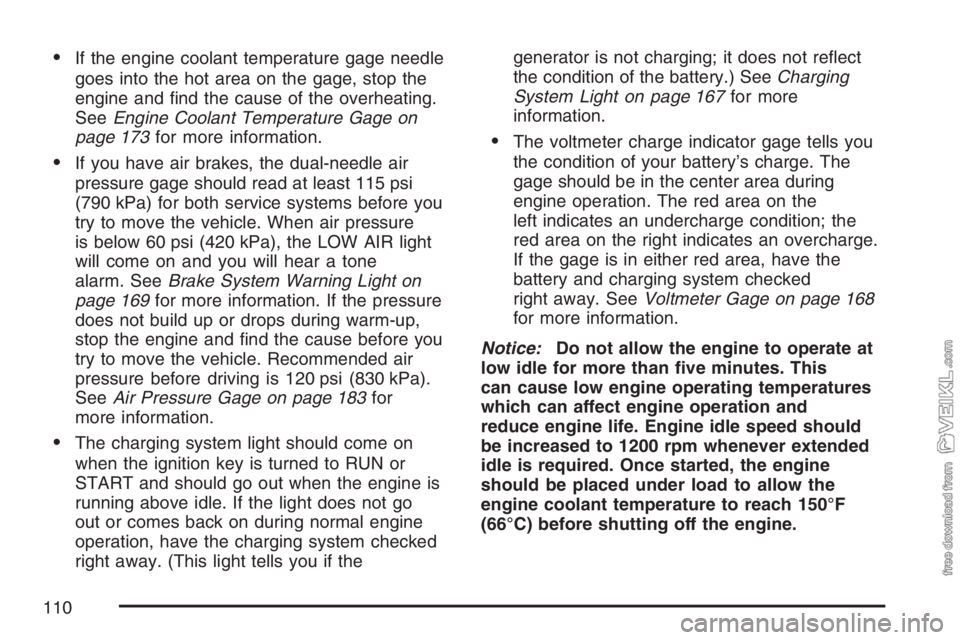
•If the engine coolant temperature gage needle
goes into the hot area on the gage, stop the
engine and find the cause of the overheating.
SeeEngine Coolant Temperature Gage on
page 173for more information.
•If you have air brakes, the dual-needle air
pressure gage should read at least 115 psi
(790 kPa) for both service systems before you
try to move the vehicle. When air pressure
is below 60 psi (420 kPa), the LOW AIR light
will come on and you will hear a tone
alarm. SeeBrake System Warning Light on
page 169for more information. If the pressure
does not build up or drops during warm-up,
stop the engine and find the cause before you
try to move the vehicle. Recommended air
pressure before driving is 120 psi (830 kPa).
SeeAir Pressure Gage on page 183for
more information.
•The charging system light should come on
when the ignition key is turned to RUN or
START and should go out when the engine is
running above idle. If the light does not go
out or comes back on during normal engine
operation, have the charging system checked
right away. (This light tells you if thegenerator is not charging; it does not reflect
the condition of the battery.) SeeCharging
System Light on page 167for more
information.
•The voltmeter charge indicator gage tells you
the condition of your battery’s charge. The
gage should be in the center area during
engine operation. The red area on the
left indicates an undercharge condition; the
red area on the right indicates an overcharge.
If the gage is in either red area, have the
battery and charging system checked
right away. SeeVoltmeter Gage on page 168
for more information.
Notice:Do not allow the engine to operate at
low idle for more than �ve minutes. This
can cause low engine operating temperatures
which can affect engine operation and
reduce engine life. Engine idle speed should
be increased to 1200 rpm whenever extended
idle is required. Once started, the engine
should be placed under load to allow the
engine coolant temperature to reach 150°F
(66°C) before shutting off the engine.
110
Page 112 of 430
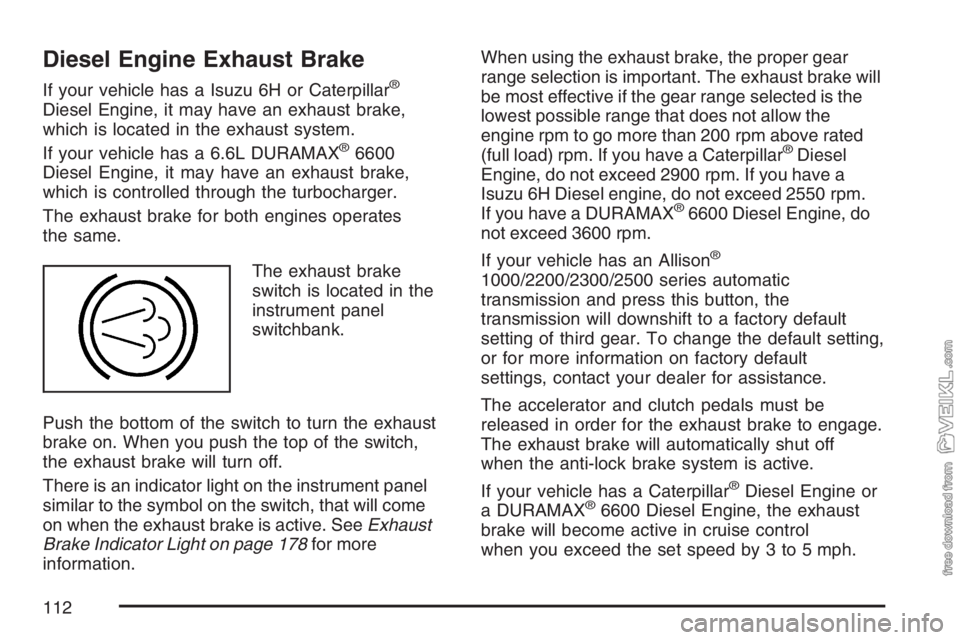
Diesel Engine Exhaust Brake
If your vehicle has a Isuzu 6H or Caterpillar®
Diesel Engine, it may have an exhaust brake,
which is located in the exhaust system.
If your vehicle has a 6.6L DURAMAX
®6600
Diesel Engine, it may have an exhaust brake,
which is controlled through the turbocharger.
The exhaust brake for both engines operates
the same.
The exhaust brake
switch is located in the
instrument panel
switchbank.
Push the bottom of the switch to turn the exhaust
brake on. When you push the top of the switch,
the exhaust brake will turn off.
There is an indicator light on the instrument panel
similar to the symbol on the switch, that will come
on when the exhaust brake is active. SeeExhaust
Brake Indicator Light on page 178for more
information.When using the exhaust brake, the proper gear
range selection is important. The exhaust brake will
be most effective if the gear range selected is the
lowest possible range that does not allow the
engine rpm to go more than 200 rpm above rated
(full load) rpm. If you have a Caterpillar®Diesel
Engine, do not exceed 2900 rpm. If you have a
Isuzu 6H Diesel engine, do not exceed 2550 rpm.
If you have a DURAMAX
®6600 Diesel Engine, do
not exceed 3600 rpm.
If your vehicle has an Allison
®
1000/2200/2300/2500 series automatic
transmission and press this button, the
transmission will downshift to a factory default
setting of third gear. To change the default setting,
or for more information on factory default
settings, contact your dealer for assistance.
The accelerator and clutch pedals must be
released in order for the exhaust brake to engage.
The exhaust brake will automatically shut off
when the anti-lock brake system is active.
If your vehicle has a Caterpillar
®Diesel Engine or
a DURAMAX®6600 Diesel Engine, the exhaust
brake will become active in cruise control
when you exceed the set speed by 3 to 5 mph.
112